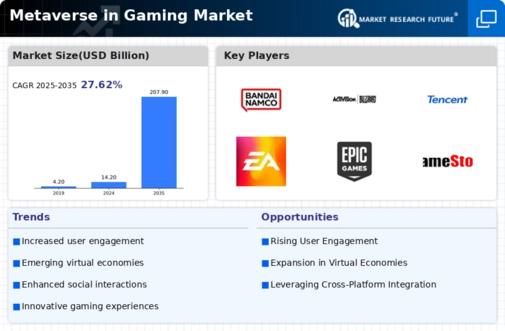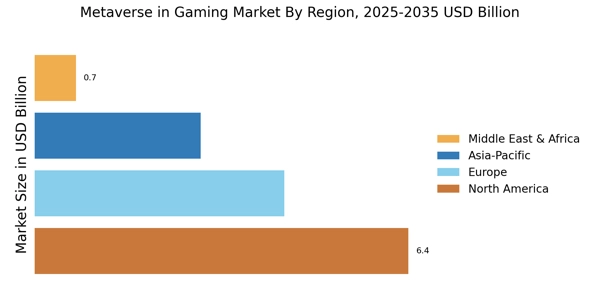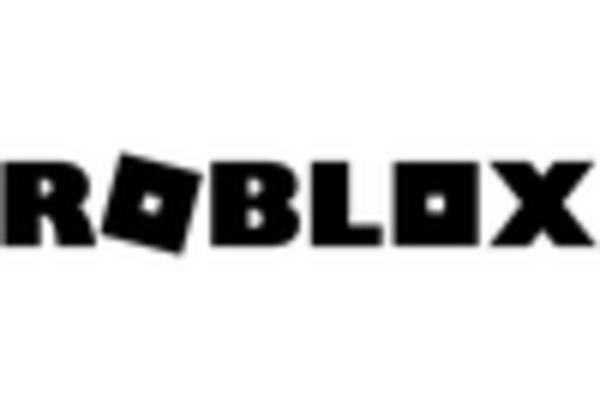Expansion of Cross-Platform Play
The Metaverse in Gaming Market is witnessing a notable expansion in cross-platform play capabilities. This trend allows players on different devices to interact and compete within the same gaming environment, fostering a more inclusive gaming community. As of October 2025, it is estimated that over 70% of new games are designed with cross-platform functionality, which significantly enhances player engagement and retention. This inclusivity not only broadens the potential user base but also encourages social interactions among players, thereby enriching the overall gaming experience. The ability to connect with friends regardless of their gaming platform is likely to drive further growth in the Metaverse in Gaming Market, as it aligns with the increasing demand for social gaming experiences.
Rise of Esports and Competitive Gaming
The Metaverse in Gaming Market is significantly influenced by the rise of esports and competitive gaming. This phenomenon has transformed gaming into a spectator sport, attracting millions of viewers and participants worldwide. As of October 2025, the esports market is projected to exceed 1.5 billion USD, highlighting its growing importance within the gaming ecosystem. The competitive nature of esports fosters community engagement and encourages players to invest time and resources into their gaming experiences. This trend not only boosts the visibility of the Metaverse in Gaming Market but also attracts sponsorships and partnerships, further fueling its growth. The integration of esports into the metaverse creates unique opportunities for immersive viewing experiences, thereby enhancing the overall appeal of the gaming landscape.
Increased Investment in Game Development
The Metaverse in Gaming Market is currently experiencing increased investment in game development. As developers recognize the potential of the metaverse, funding for innovative projects is on the rise. In October 2025, it is estimated that venture capital investments in gaming startups have reached approximately 4 billion USD, reflecting a strong belief in the future of immersive gaming experiences. This influx of capital enables developers to experiment with new technologies and create more engaging content, which is essential for attracting and retaining players. The focus on high-quality graphics, storytelling, and interactivity is likely to enhance the overall gaming experience within the Metaverse in Gaming Market, making it a more competitive and dynamic environment.
Advancements in Virtual Reality Technology
The Metaverse in Gaming Market is experiencing a surge in advancements in virtual reality (VR) technology. Enhanced VR headsets and immersive environments are transforming the gaming experience, allowing players to engage in more realistic and interactive gameplay. As of October 2025, the market for VR gaming is projected to reach approximately 12 billion USD, indicating a robust growth trajectory. This technological evolution not only attracts gamers but also encourages developers to create more sophisticated and engaging content. The integration of haptic feedback and motion tracking further enriches the user experience, making the Metaverse in Gaming Market increasingly appealing to a broader audience. Consequently, the demand for VR-compatible games is likely to rise, driving investment and innovation within the sector.
Growing Popularity of Subscription-Based Models
The Metaverse in Gaming Market is increasingly adopting subscription-based models, which offer players access to a wide array of games for a fixed monthly fee. This trend appears to be reshaping the way consumers engage with gaming content. As of October 2025, subscription services are projected to account for nearly 30% of the gaming revenue, indicating a shift in consumer preferences towards more flexible payment options. This model not only provides gamers with access to diverse titles but also encourages developers to create high-quality content to retain subscribers. The rise of subscription services is likely to enhance the sustainability of the Metaverse in Gaming Market, as it fosters a steady revenue stream while promoting continuous engagement among players.


















Leave a Comment